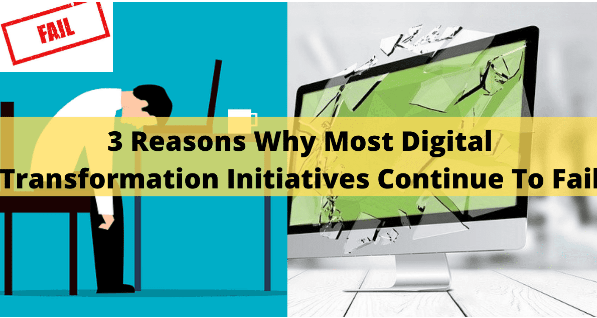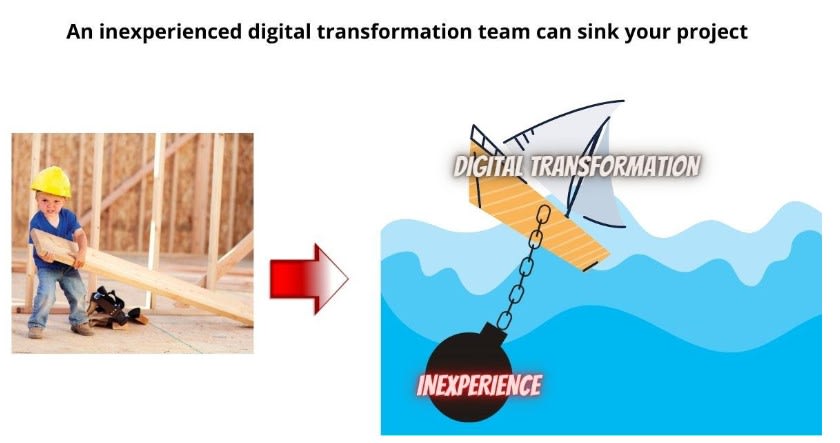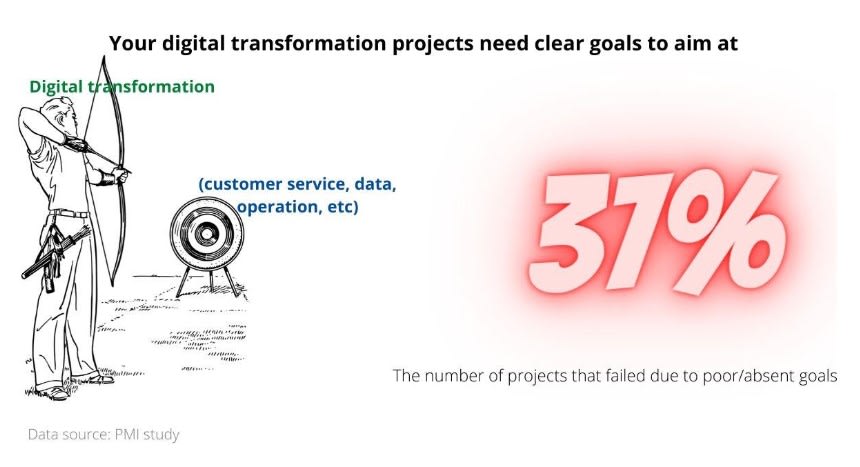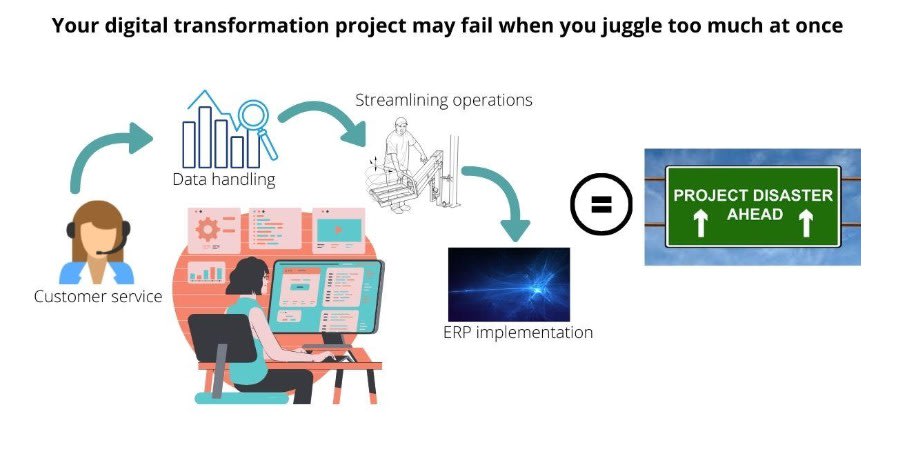3 Reasons Why Most Digital Transformation Initiatives Continue To Fail
In this article, we’ll be discussing 3 reasons why most digital transformation initiatives continue to fail so you can be aware of those red flags, and avoid them altogether.

Are you thinking about initiating a digital transformation campaign in your company?
If so, you may be worried about what could go wrong, and the challenges that possibly lie ahead. You’ve probably heard about the many unsuccessful stories, and you’re right to be concerned.
Boston Consulting Group conducted a digital transformation study in 2020 to find out why such projects are missing the mark. It came to light that 7 in every 10 digital transformation projects do not live up to expectations, for a variety of reasons. These include unclear goals, doing too much too fast, and lack of experienced professionals, among others.
Experience may be the best teacher, but in this case, it’s preferable to learn from someone else rather than your own. Mistakes mean costly financial consequences for your business.
In this article, we’ll be discussing 3 reasons why most digital transformation initiatives continue to fail so you can be aware of those red flags, and avoid them altogether.
Let’s get started.
1. Lack of Expert Assistance
How hard can digital transformation be?
“I can probably do it on my own, and my staff can adequately fill the roles that the project requires.” This is the kind of thinking that leads down the road to disaster.
The lone wolf mentality is among the leading causes of digital transformation failures.
If your digital transformation team is inexperienced because they’ve not gone through proper digital transformation training, your business will have to deal with impossible goals and bad strategies stemming from a poor planning process.
Also, risk assessment will not be carried out properly, and you won’t know what pitfalls lie ahead until you’re already knee-deep in the problem.
Don’t follow in the footsteps of bad examples by overestimating the skill sets and talent of your members. New technologies require specialized help for successful implementation into your business.

You need to choose competent technology partners, to execute the project, and also to train your staff on how to be tech-savvy with regard to the new systems.
Of course, there are several things you’ll need to consider when selecting your digital transformation agency of choice. Some of those considerations include:
- The budget available to you
- The portfolio of the agency
- Workflow compatibility
Another important thing to keep in mind is that the success of your project also depends on leadership and whether you have competent people at the top of the hierarchy.
For example, do you have a CIO or Chief Information Officer position at your company?
If not, it’s time to reconsider your structure. A CIO brings technological relevance to the table and can steer digital transformation projects or make the change easier for your business and employees.
With ever-expanding technologies and new digital platforms becoming more sophisticated by the day, a CIO offers your business the opportunity to keep up in a constantly changing world of technology. So be sure to get someone qualified in that capacity for your business.
2. Obscure Or Undefined Goals
Digital transformation has become somewhat of a bandwagon if you want your business to look cool and in keeping with the times.
But if that’s your only motivation for the project, it’s likely doomed before it starts.
A digital transformation project without clear goals or key performance indicators is like catching the wrong bus. You aren’t quite sure where you’re going, whether you’re on the right track, and if you should be on that bus in the first place.
According to a PMI report, 37% of projects fail because of unset or unclear goals. That means approximately 4 in every 10 digital transformation projects don’t pull through because of goals, resulting in a lot of wasted time and resources.
So, the first step of setting up your digital transformation campaign to be successful is to define your business’ project goals, and how these will profit your organization or business.

For example, say you’d like to get an eCommerce WordPress website, separate from your current website, as part of the digitalization process to reach a wider market. You want to create a digital store where your clients can shop for items without having to come to the physical store.
The goal here would be to increase lead generation. Perhaps, instead of having 100 clients coming into the store, you’d want your products to be seen by ten times that number in one day.
In this case, there is a clear KPI or metric for success, and you know what your project is setting out to do for you.
You can measure the number of click-throughs your products are getting by web analytics tools like Bitly, for example, to determine if the website is generating the right buzz.
Of course, it’s always important to be realistic with your expectations as well, which is why you should get professional help for your project. Overambitious goals are another reason why some digital transformation projects fail.
3. Doing Too Much, Too fast
Another reason why digital transformation fails is an undefined scope.
If your project is trying to implement all sorts of digital initiatives at the same time, you’re likely spreading resources too thin and also rushing through important processes.
What’s more, juggling multiple digital transformation projects means not having enough time to gauge the success of a system before moving on to another or scaling it up.
Consequently, if one of your technological renovations is based upon the success of another, there’s an expensive chain reaction of failure when the first element doesn’t hold up as expected.
For example, say you want to create a database that eases the availability of client information across your various organizational branches. However, after putting in place infrastructure for this database, you realize you need to improve your data collection method in order to improve cross department communication in your organization.
You consider intelligent document processing software now. However, you realize the technology requires some overhaul to the data input mechanisms of the system you just spent so much to implement.
And why did you or your team miss this error in judgment?
Maybe because you were also working on your Enterprise Resource Planning (ERP) system on the side as well, so you didn’t properly think through the first idea.

In line with a famous Steve Jobs quote, think big, but start small. Hence, you want to create a scope and implement digital transformation in phases.
For instance, you could split the project into certain key categories such as customer service, data handling, and operational efficiency, among others.
Now take each category of digital transformation and focus on that, according to a pre-designed timeline, while also leaving enough window after the project to measure ROI.
Let’s consider customer service as an example.
You’ll start with a plan, outlining your customer service goals, and your team of digital transformers will offer options.
Objectives could be creating more customer feedback channels or reducing communication turnaround time.
Your team may suggest language analytic tools, optical character recognition, among other solutions. Once you have all the cards on the table, you can weigh the benefits of implementing one option over the other and find the best way forward.
Conclusion
What part of digital transformation turns out to be most challenging for you? Will you be implementing a digital transformation project at your company after what you know now?
If not, you should. Digital transformation offers many benefits for your business.
It allows you to improve your customer experience, cut down on costs, and gives you a competitive advantage.
However, this type of project includes a fair share of challenges.
While beneficial, it’s important to be wary of the pitfalls of digital transformation, which include overreaching scope, unclear goals, and inexperienced personnel.
As always, thorough planning is the key to success in your digital implementation process. You’ll also need to set out clear and realistic goals in addition to recruiting an experienced digital transformation agency.
